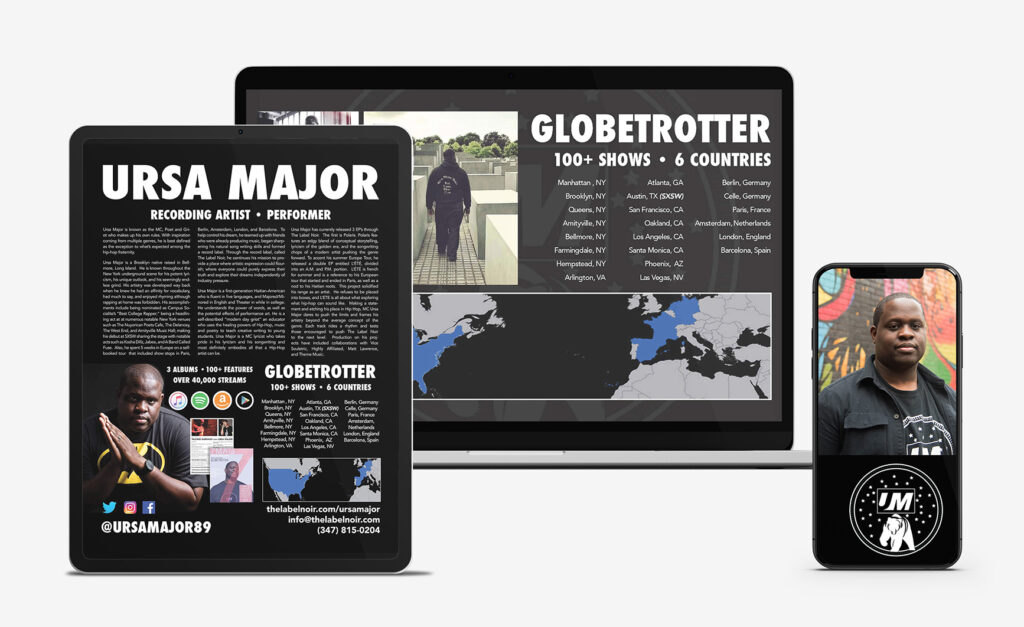Why You NEED an EPK
Whether you’re a rapper, singer, solo artist or rock band, you’ve probably heard at some point that you absolutely NEED an electronic press kit, or EPK for short.
A professionally created EPK is a major part of marketing your music and often makes the difference between being perceived as a “nobody” or as a real industry player. Booking agents, program directors at radio stations, and music journalists all want to see your EPK; and if it sucks, you suck. Sorry, not sorry. If you want to play with the big dogs, you have to play LIKE the big dogs. So let’s take a look at how exactly to create an EPK that will get you more attention. An EPK that will truly help you achieve success in the music industry. Let’s get started:
What Does an EPK Look Like?
Long, long ago, in the mid 2000’s and even before that, a Press Kit was a physical collection of photos and documents that an artist or their manager would place in an envelope and physically deliver or mail to a record-label executive or perhaps a radio-station manager.
In todays modern society, most of this is done virtually with digital files. The first thing most artists do is create a website to host all of the photos, documents, musical examples, videos, etc. they would like to include in their press kit. A website URL is easy to share in email or text, and these days, most websites are mobile friendly to be easily accessed on phones and tablets.
What Does an EPK Include?
If someone is looking at your band’s EPK without ever having met or spoken to you, they should be able to: Understand who you are, know what your music sounds like, know where to find your music, and most importantly: know how to contact you.
It’s good to include video clips of your best performances, links to articles or reviews that have been published about you or your music, and information on any sponsorships you may have.
One warning: Don’t go overboard. The industry people receiving your EPK don’t have all the time in the world to look at an encyclopedia on your whole life. Only include enough stuff to get someone interested and give them methods to contact you.
How to Write Your Bio
Keep this short and sweet. Again, don’t overload anybody with boring information and a whole story of your band’s journey or musical growth from the time you first heard music in your childhood. But also, make sure to craft this part very carefully; Many journalists simply use a band’s official bio instead of writing their own version of it, so providing a short and easy-to-read bio will increase the likelihood that a writer will copy it and put it in print. You may want to consider hiring a professional copy writer to make sure the words on your page have maximum impact.
Your Official Logo
Just like with your artist bio, many music blogs, journalists, and publications will include your official logo or any other artwork you might have. Make sure all of these assets are high resolution, look good, and are professionally designed. A logo has to stand out and compete in a real industry market. You don’t want yours looking like you drew it yourself in MS Paint.
Artwork, Photos and Videos
It can be a challenging task to curate a collection of quality photos of yourself or your band. While it’s easy to use a smart phone to take some quick photos, it’s well worth the cost to have a professional photographer take your official artist photos, and people can tell the difference. Especially industry people.
This goes for video too: High quality, professionally shot video clips of your live performances or rehearsals show people what to expect when you hit the stage.
Music, of Course.
Always include links to your music or at least information on where to find it. With so many distribution options out there, both paid and free, there’s no excuse to not have samples of your music available…Unless of course you have no recordings… Then you’ll have to rely on your video content… It’s better to just start recording, even if it’s at home with your laptop.
How to Share Your EPK
In today’s quickly paced industry, a simple, one-page website is the best way to go about sharing your EPK. Your site should have links to your YouTube channel and your other social media accounts.
In addition to your own website, you should look at any other platforms that you might be able to use: Bandcamp, ReverbNation, and Spotify each give options for uploading assets like photos, bios, logos, and artwork.
Another option is to create a PDF document with all of these assets, and share it by email or on a physical USB drive.
It’s also a good practice to have a condensed, one-page version of your press kit to print on regular 8.5”x11” letter-sized paper. It helps to leave someone with a physical piece of paper they can refer to.
Bottom Line: You Need an EPK.
With all of this stuff to think about, putting together an EPK can feel overwhelming at first.
But just keep in mind the goal: You want to make it easy to show someone who you are, what your music sounds like, and how to contact you. That’s it.
Your EPK needs to convey that you’re passionate about what you do and go about it professionally. You have to show that you’re no amateur.
Here at Choppa Media, we’re musicians too. Many of our clients are also artists and we’ve put together many EPKs throughout the years. Give us a call, or send us a message today and we can help you with every aspect of putting together a press kit that will take your success in the music industry to new heights and truly have the industry buzzing!
